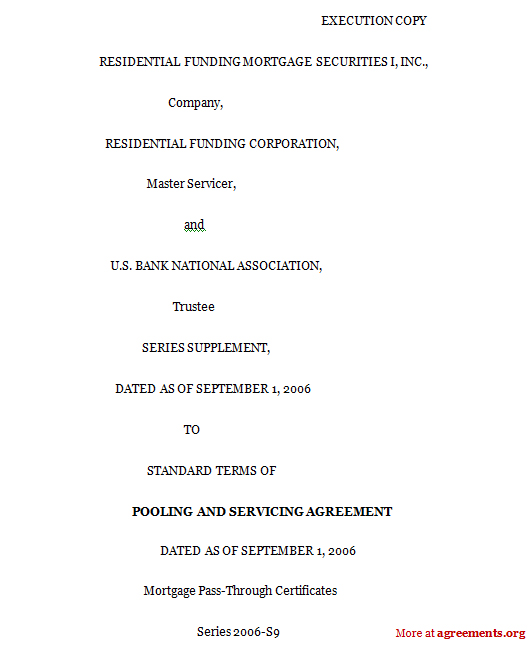Pooling and Servicing Agreement, also known as PSA agreement, is commonly used in the finance market. It is created when different mortgage loans are bundled to create a commercial mortgage-based security (CMBS). This security is then sold to investors. Once the agreement comes into effect, the security becomes the owner of all the mortgages that have been bundled.
When Do You Need Pooling and Servicing Agreement?
A pooling and servicing contract allows investors to gain rewards that otherwise they would not have enjoyed had they invested in a single loan. Investing in the pooled loans reduces the risks investors face by diversifying the types of property, property sizes and property markets.
The Purpose of Pooling and Servicing Agreement
The main purpose of the pooling and servicing contract is to define the roles of the different parties and the rights of the investors. Usually, the participants in the agreement are the loan sellers, master servicer, special servicer, operating advisor, trustee, certificate administrator and investors. The agreement helps each party to know their responsibilities and roles when they are part of the security.
Inclusions in Pooling and Servicing Agreement
Inclusions in the agreement include boilerplate clauses as well as clauses and terms that the participants negotiate and agree with. Usually, the agreement is organized into about 12 articles, and the key provisions are stated in the same articles across the securities.
For instance, Article I will have the definitions while Article II will have the terms and conditions for servicing the loans stated in Article III. And, any provision pertaining to distributions to investors, also known as certificate holders, is mentioned in Article IV.
The agreement also contains the names of the participants along with the details, and their duties, rights and obligations. Some of the other essentials include:
- Steps to create a trust
- How the mortgages that are bundled will be transferred to the trust
- How the securities will be issued
How to Draft Pooling and Servicing Agreement
While drafting this agreement, the originator of the loans (the bank or financial institution) bundles loans that similar. Once this happens, the pool becomes a commercial mortgage-backed security, which is sold in the secondary market. The purchaser is often a trust that comprises investors, who get paid by the trust.
When drafting the agreement, the following details should be included in it:
- Name the different participants
- Name the trust
- Details of pooled mortgages
- Originator of the mortgages
- Servicer of the trust
- Details of the special servicer
- Details of the agency monitoring the pool
- Duties, obligations and rights of each participant
- Fees paid to the servicer
- How the fees paid will be used
As the PSA is considered a security, it has to be registered with the Security and Exchange Commission (SEC).
Pros and Cons of Pooling and Servicing Agreement
Some advantages of this agreement are:
- Helps diversify investment risks
- Ensures better returns to investors
- Minimizes mismatch between assets and liabilities
- Requires low capital
The disadvantages associated with pooling servicing agreement include:
- High cost of administering the trust
- There are always risks for the investor in case the originator or borrower files for bankruptcy
- Early amortization of loans can minimize profits for the investor
Types of Pooling and Servicing Agreement
Types of pooling and servicing agreement depend on the type of trust established. This agreement can be created for the following trusts:
- Master Trust: This trust pools revolving credit card balances
- Issuance Trust: It started in 2000 by Citibank for securities backed by credit cards. It does not have any limitation that Master Trust tends to have.
- Grantor Trust: This trust is for REMICs (real estate mortgage investment conduits) and securities backed by automobiles.
Key Terms / Clauses in Pooling and Servicing Agreement
Some of the key terms of the agreement include the following:
- Conveyance rules for the trust that ensures transfer of each mortgage loan to the trust
- Acceptance of mortgage loans by the trust and trustee
- Original mortgage notes along with the complete chain of endorsement until the last endorsee
- Payments to the certificate holders (investors)
- Trust advisor expenses
- Representations and warranties of the master servicer, special servicer, trust advisor, certificate administrator and tax administrator
- Collection of mortgage loan payments
- Details of taxation, servicing accounts and reserve accounts
- Investment of funds in the account
- Realization upon defaulted mortgage loans
[Also Read: Mortgage Financing Agreement]
What Happens When You Violate Pooling and Servicing Agreement
If there is breach of the pooling and servicing agreement, the parties that have signed the agreement can enforce the termination events listed in the agreement. Alternatively, the parties can opt for arbitration. If that fails, the parties can file a lawsuit based on the jurisdiction that covers the agreement.
Download Pooling and Servicing Agreement Sample
A sample of the agreement can be downloaded from below.
